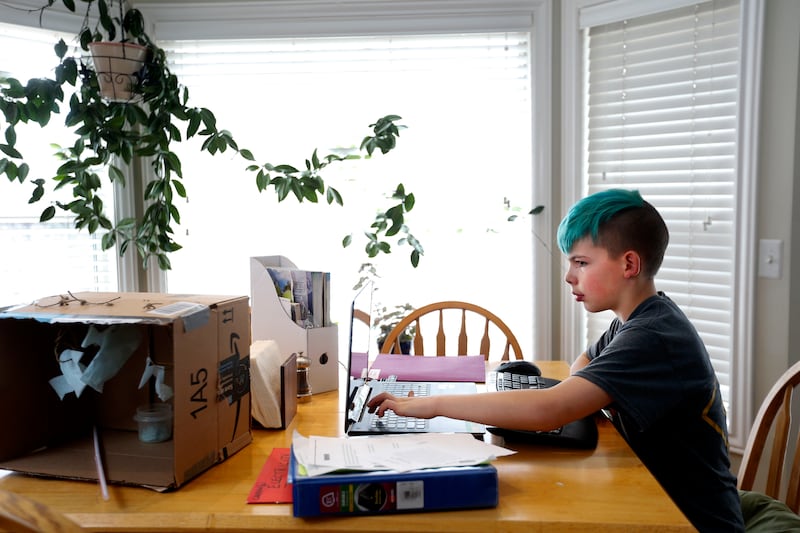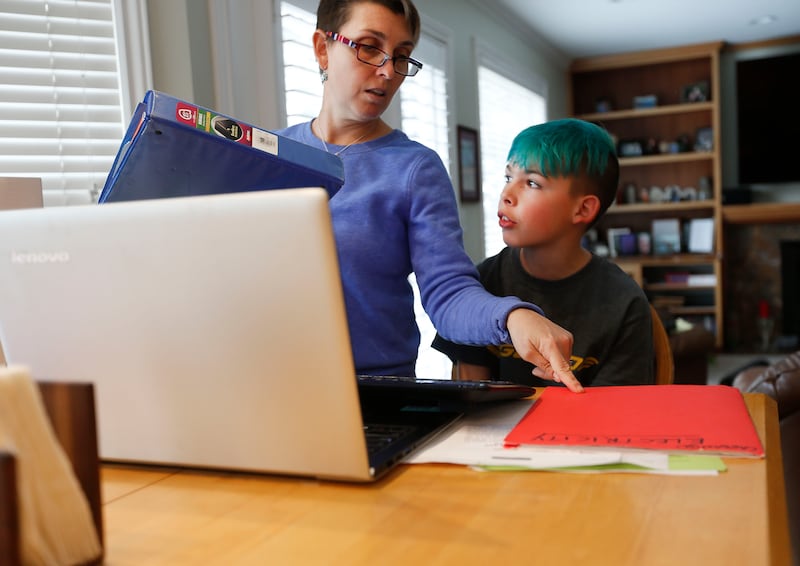SALT LAKE CITY — Johanna Williams, a busy working mom of four children, has been pressed into overdrive.
Williams is a part-time STEM teacher at East Sandy Elementary, where her two youngest children attend school. Her other children are junior high age, one who attends a neighborhood school and the other who goes to a public charter school.
She teaches high school social studies for BYU Independent Study and enrollment in her classes has steadily climbed since Utah schools instituted a statewide soft closures of schools one week ago.
Williams also serves as a PTA council president, working with 10 Canyons School District elementary schools.
She is also one of hundreds of thousands of Utah parents — and millions nationally — who have been pressed into the role of home educators. As of Utah Gov. Gary Herbert’s announcement on Monday, Utah schools will observe “soft closure” until May 1.
That means the near 667,000 children who attend Utah public schools will continue to learn from home, with their parents facilitating their learning from dining room tables via technology or with paper packets sent home by their schools.
Williams is guiding the instruction of her four children at home, navigating four different curricula from three schools that all use different instructional platforms.
“It’s a lot,” she said.
Williams has the decided advantage of teaching online herself, and still she encounters challenges.
“I can’t help my (junior high-age) son with his math. I’m terrible at math. He’s really on his own there,” she said.
Sometimes technology they use gets bogged down with traffic and they can’t readily access their work.
“I’m noticing that our bandwidth is not enough,” she said. Most of her children were on Canvas and it was taking 10 minutes to download the pages they needed.
“Finally we all got frustrated and went for a scooter ride,” Williams said.
Another challenge is feeding four children at home who ordinarily pack a lunch or eat school lunch. “We’re running our dishwasher two to three times a day,” she said.
On Friday, the Williams family made homemade pizza for lunch. Williams had to cut her conversation with the Deseret News short because she had dough on her hands and “my kids are looking at me like ‘Get off the phone.’”
Despite the frustrations and challenges, the time spent together as a family has been rewarding, Williams said.
Her children ordinarily spend time with their friends but “are now playing together in ways they haven’t for years,” she said.
On Sundays, the family has worshipped together at home because their church services have been suspended. “It was amazing to see our kids taking that part of their lives so seriously,” Williams said.

As for school, Williams is trying to keep her kids in a routine but also making sure it’s not “drill and kill.” It’s important to give kids choice and options, she said.
The Williams children are taking part in a home book club centered on the “Dog Man” book series. “It’s fun and it’s something we all can do,” she said.
While the Williamses try to navigate the academic and logistical aspects of Utah’s school closure, Williams said she is also concerned about the social and emotional aspects of children not being in school. Her youngest child, who is in second grade, especially misses her friends and teacher.
To the school’s credit, the principal, teachers and a school counselor have been sending students regular greetings and messages of encouragement. The school counselor has been communicating with students via video discussing their concerns about the school closure, COVID-19 and, after Wednesday’s earthquake, their safety.
For that matter, Williams and her teaching colleagues at East Sandy Elementary School miss each other, too, although the educators take part in an online faculty meeting each morning on school days.
Part of the stress, Williams said, is that no one knows how long social distancing measures will be necessary.
State Superintendent of Public Instruction Sydnee Dickson, addressing the Utah State Board of Education late last week, said she had heard reports of teachers who had prepared four weeks of lessons.
“So I feel like our teachers, even though they’ve been nervous and concerned and overwhelmed and (then the) earthquake, that the e-learning is really going well,” Dickson said.
Faith Crabill, who is an occupational therapist who works with patients in their homes, said her flexible schedule enables her to address the additional responsibility of helping her son Caedan with his schoolwork.
Crabill said she has enjoyed the additional family time but her son, who is an only child, prefers his routine.
“He misses his school. He misses his teacher. He misses his friends,” she said.
Crabill’s family has taken the attitude of “we’ll do what we need to do” toward the soft closure of schools and abiding by social distancing guidelines. Her son’s teacher slipped him his work through an open window in her classroom, a sign of the times.
Much will depend on how long the dismissal will be necessary, Crabill said.
“I can’t imagine doing this for good because I think we’d go a little crazy,” she said. As an only child, Caedan relies on school and his friends for socialization more than children in larger families, Crabill said.
On the other hand, social distancing has had some upsides. Fewer people are commuting so the air is cleaner and more people are venturing outdoors to exercise, she said.
Kristen Evans, whose sons are in second and fourth grade at Granite School District’s Woodstock Elementary School, said her boys started their at-home lessons as scheduled on Wednesday despite the 5.7 magnitude earthquake and dozens of aftershocks throughout the day.
“We still did it as a family because we had the tools necessary at home,” she said.
While some kids took last Thursday and Friday off for spring break, Evans said she and her husband insisted their boys read and do their math exercises anyway.
“We’ve got to stay sharp. Otherwise we might go crazy if we have to be together two to four weeks,” she said.
As a parent, Evans said she was impressed by the efforts of teachers who quickly transferred classroom lessons to online platforms.
Woodstock teachers are using Google Classroom and teachers explain their lessons on videos they have produced.
Evans said her sons were easily able to log on and access the instructional platform.
“The kids knew exactly what do,” Evans said. “When I asked my son if he needed help, he said ‘Oh, mom. I know what I’m doing.’”
They likewise knew what to do when the earthquake shook the Salt Lake Valley.
Still, they are young boys. “They were rattled inside and out, but we made it through,” said Evans, who is chairwoman of Woodstock’s school community council.
Although Utah’s statewide school dismissal is now scheduled through May 1, Evans said she is “mentally prepared for my kids not to go back to school until August.”
So far, her family has approached this chapter in life as an adventure, but it’s early on in the “soft closure.”
While her boys learn at home, Evans, who works in the mortgage industry, is working from home, too. The uncertainty of the financial markets is posing great challenges for her professionally.
All she can do, both as a working professional and home-schooling parent, is “hunker in” to help facilitate her sons’ learning, and tend to her work while the family does its part to help curb the spread of COVID-19, she said.
The dismissal has been an opportunity for Evans’ family to slow down their busy lives, spend more time together and concentrate on what matters most.
“I’m choosing to stay positive,” she said.
Erik Hanson, president of the Utah Home Education Association, said there are many helpful resources available online that are used by home-schoolers that would also be useful to parents who have been pressed into instructing their kids at home.
He recommends that parents not try to duplicate the structure of the school day, because the school day is seven hours long and not all of that time is instructional.
Hanson suggests working on one or two subjects each day and being flexible enough to concentrate on each child’s strengths and weaknesses.
One of the benefits of home education is individualized instruction, he said.
“I don’t think there is such a thing as one-size-fits-all,” he said.
Mostly, parents need to be patient. When their kids are struggling, everyone needs to take a break.
“It doesn’t help to shout at your kids when they’re melting down. When kids are ready to learn, they will learn,” he said.
Hanson also recommends that children avoid screen time before morning lessons.
“Save screen time for the reward at the end of the day unless it’s actually learning screen time,” he said.
Hanson said he’s heard from a number of parents who have been pleasantly surprised at the array of resources that can support learning at home. They’re learning that it’s doable.
“We’ve already had a lot reach out and say ‘I’m just going to keep home schooling.’ I say, great.”


